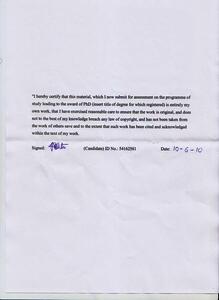Mehta, Jai Prakash (2010) Gene expression analysis in breast cancer. PhD thesis, Dublin City University.
Abstract
Breast cancer is the most common type of cancer among females, both in incidence and death. As meaningful biological understanding of the disease is confounded by the existence of various molecular groups and sub-groups, the challenge for targeted drug development may lie in understanding the molecular mechanisms of various sub-groups in breast cancer.
An in-house breast cancer gene expression dataset comprising 17 normal and 104 tumour samples was analysed to identify important genes and pathways relevant to various clinical parameters. Our results identified groups of patients with similar expression profiles, the possible biology driving them and the clinical implications. Comparing Normal and Cancer specimens’ gene expression profiles, TP53, along with cell cycle genes, were up-regulated in cancer samples. Embryonic stem cell pathway genes were up-regulated, while fatty acid biosynthesis pathways were down-regulated in tumors vs normal.
The cancer specimens largely clustered with respect to ER status. Meta-analysis was performed on in-house datasets along with five public datasets to identify ER pathway genes. The analysis identified novel genes which had not been previously associated with ER-related pathways in cancer. Nuclear receptor pathways were up-regulated in ER-positive tumors/cell lines. Mining for ESR1-correlated genes across 5897 specimens identified FOXA1, SPDEF, C1ORF34 and GATA3 expression to be highly correlated.
Three sub-clusters were identified among the ER-negative cluster. One represented ERBB2 over-expressing cluster. Additionally two unique groups of patients, with significant differences in survival, previously un-identified by other studies, were identified among the ER-negative cluster; a good prognosis cluster with high expression of Immune response genes; and a bad prognosis cluster with high expression of Ropporin, over-expression of which was also linked to high incidence of relapse in our study. siRNA knockdown of Ropporin (ROPN1 and ROPN1B) in the M14 melanoma cell line impaired cancer cell motility and invasion. Knockdown of ROPN1B in MDA-MB-435s reduced motility. In the first study of its kind our results validated the role of Ropporin in cancer cell motility and invasion.
A list of 162 relapse-associated prognostically-important genes was used to develop a Neural Network back propagation model to predict the clinical outcomes. The model was successful in predicting relapse with 97.8% accuracy and outperformed existing models, indicating a strong possibility of its use as diagnostic model.
Metadata
| Item Type: | Thesis (PhD) |
|---|---|
| Date of Award: | March 2010 |
| Refereed: | No |
| Supervisor(s): | Doolan, Padraig and Clynes, Martin |
| Uncontrolled Keywords: | breast cancer; |
| Subjects: | Biological Sciences > Bioinformatics Biological Sciences > Biology Biological Sciences > Cell biology Biological Sciences > Molecular biology Medical Sciences > Cancer |
| DCU Faculties and Centres: | DCU Faculties and Schools > Faculty of Science and Health > School of Biotechnology Research Initiatives and Centres > National Institute for Cellular Biotechnology (NICB) |
| Use License: | This item is licensed under a Creative Commons Attribution-NonCommercial-No Derivative Works 3.0 License. View License |
| ID Code: | 15050 |
| Deposited On: | 29 Mar 2010 15:09 by Padraig Doolan . Last Modified 19 Jul 2018 14:49 |
Documents
Full text available as:
Preview |
PDF (main thesis)
- Requires a PDF viewer such as GSview, Xpdf or Adobe Acrobat Reader
7MB |
|
Microsoft Excel (appendix 1)
118kB | |
Preview |
PDF (appendix 2)
- Requires a PDF viewer such as GSview, Xpdf or Adobe Acrobat Reader
19MB |
Preview |
PDF (appendix 3)
- Requires a PDF viewer such as GSview, Xpdf or Adobe Acrobat Reader
10MB |
|
Microsoft Excel (appendix 4)
1MB | |
![[thumbnail of copyright declaration page]](https://doras.dcu.ie/15050/6.hassmallThumbnailVersion/jai-declaration-for-thesis.jpg)  Preview |
Image (JPEG) (copyright declaration page)
115kB |
Downloads
Downloads
Downloads per month over past year
Archive Staff Only: edit this record